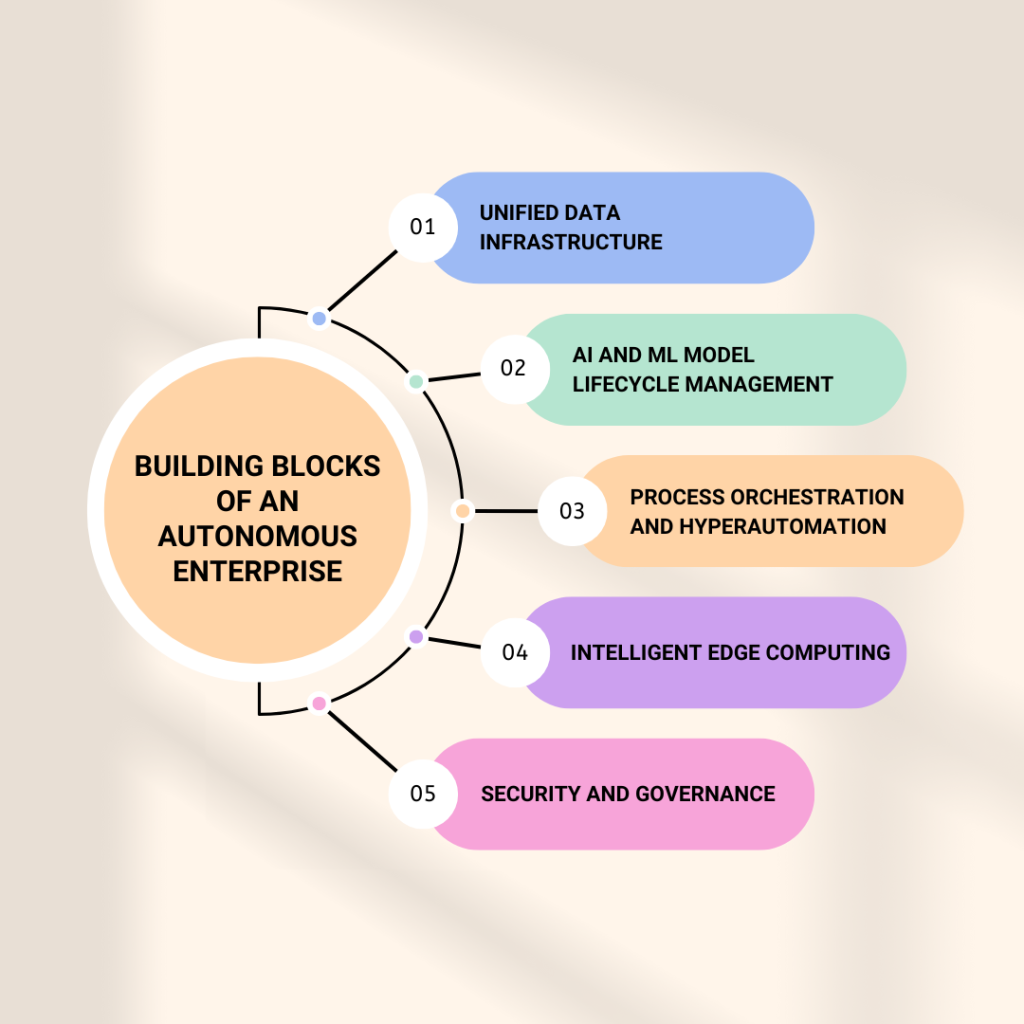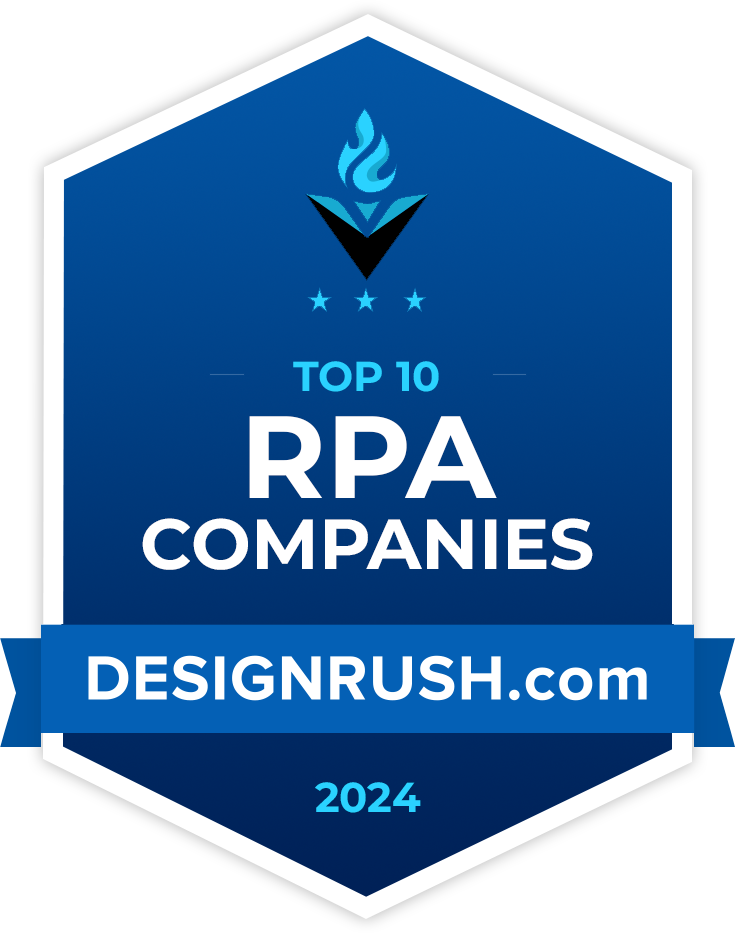
Key Takeaways
- Autonomous enterprises integrate IoT, AI, and automation to minimize manual intervention, enabling rapid, accurate decisions and continuous operational optimization.
- IoT devices collect critical data to provide real-time visibility into assets and processes, powering intelligent monitoring and proactive management.
- AI acts as the enterprise brain, analyzing patterns, predicting outcomes, and enabling self-learning capabilities that enhance agility and foresight.
- Automation empowers organizations to execute tasks at scale with high precision, from repetitive back-office operations to complex end-to-end workflows.
- A robust foundation—built on unified data infrastructure, AI model lifecycle management, orchestration, edge computing, and governance—is essential for achieving genuine enterprise autonomy.
The world of business technology is transforming very quickly. Years back, digital change meant switching to making apps and moving to the cloud, which worked wonders when used on mobile phones. At present, there is a more significant shift with the rise of autonomous enterprise. This new business type has become possible because of automation, artificial intelligence, and autonomous enterprise. It is about changing how companies function, think, and make rapid decisions quickly.
Digital tools allowed everyone to do their jobs in the best possible way in the past. Nevertheless, AI, automation, and IoT enable firms to perform several tasks independently. This means they can access quick actions, make better decisions, and make fewer mistakes. IoT connects physical devices with the internet, including tools, machines, and sensors. These devices gather real-time information, including delivery routes and machine health. This continuous flow of information allows businesses to monitor everything happening.
On the other hand, artificial intelligence collects all the patterns and data to identify issues before they arise. Lastly, automation takes over time-consuming tasks. This consists of filling out forms, sending reminders, and approving routine requests. When automation functions with IoT and AI, it becomes more innovative and brilliant. It adjusts itself to the current situation. These technologies are helping firms become creative, flexible, and independent.
Also read: Why Is UiPath Integration with Chatbots and Virtual Assistants Non-Negotiable?
Understanding Autonomous Enterprise
An autonomous enterprise is an innovative organization that has the skills to optimize, manage, and adapt to its operations with very little human input needed. It integrates IoT devices, automation, and machine learning into its imperative processes. These technologies collaborate to create a system that learns from past experiences, adjusts to changes, and keeps enhancing itself.
An autonomous enterprise is data-driven. It gathers vast amounts of data from the external environment, internal systems, and customers. Machine learning and artificial intelligence analyze the data to identify patterns, make decisions, and predict results. This means the organization can respond quickly to opportunities and issues before they occur. Innovative automation adds another layer by solving intricate workflows that, back then, required human oversight.
The key characteristics of an autonomous enterprise are as follows:
| Feature | Description |
| Self-learning | Uses AI/ML to adapt and optimize operations over time |
| Proactive Decision-Making | Predicts outcomes and takes action before issues arise |
| End-to-End Automation | Automates entire business processes, not just tasks |
| Real-Time Insights | Leverages IoT and analytics for instant visibility |
| Seamless Integration | Connects across IT and OT systems seamlessly |
The Triad of Transformation: IoT, AI, and Automation
The rise of the autonomous enterprise is driven by the seamless convergence of three powerful technologies: the Internet of Things (IoT), Artificial Intelligence (AI), and Automation. Together, they form a transformational triad that allows businesses to operate intelligently, adapt swiftly, and scale seamlessly. Each technology plays a distinct but interconnected role, acting as the senses, brain, and muscle of the modern enterprise.

1. Internet of Things (IoT): The Sensory System
IoT forms the nervous system of an autonomous enterprise. Enterprises gain real-time visibility into operational processes by embedding sensors into machines, products, infrastructure, and even people. These sensors collect vast streams of data—such as temperature, pressure, location, motion, or status—which are continuously transmitted to central systems for analysis.
Applications of IoT in Enterprises:
| Industry | Use Case |
| Manufacturing | Predictive maintenance using machine sensors |
| Healthcare | Remote patient monitoring and diagnostics |
| Logistics | Intelligent fleet management and real-time tracking |
| Retail | Smart shelves and automated inventory control |
These real-time insights allow businesses to prevent issues before they occur, optimize resource usage, reduce downtime, and provide better services. More importantly, the data collected via IoT fuels AI and automation, enabling more intelligent and autonomous operations.
2. Artificial Intelligence (AI): The Brain
If IoT provides the sensory input, AI is the brain that interprets this information, makes sense of patterns, and either recommends or independently executes decisions. AI systems continuously learn from data and improve their accuracy and decision-making over time.
Core AI Capabilities Empowering Enterprises:
| Capability | Description | Example |
| Machine Learning | Learns from data patterns | Fraud detection in banking |
| Natural Language Processing | Understand human language | Virtual agents for customer service |
| Computer Vision | Analyzes visual data | Quality control in manufacturing |
| Predictive Analytics | Forecasts future trends | Demand planning in retail |
By applying these capabilities, AI helps businesses become more responsive, predictive, and customer-focused. Whether detecting fraud, improving supply chains, or enabling personalized customer experiences, AI is at the heart of autonomous decision-making.
3. Automation: The Muscle
Automation acts as the execution arm of the autonomous enterprise. It translates insights and decisions into action, ensuring tasks are completed accurately, quickly, and without fatigue. From back-office functions to customer-facing workflows, automation brings efficiency at scale.
Types of Automation Technologies:
| Type | Description | Tools |
| Robotic Process Automation | Automates rule-based digital tasks | UiPath, Power Automate |
| Intelligent Automation | Combines AI and RPA for smarter tasks | Automation Anywhere, DRUID AI |
| Autonomous Agents | AI-driven systems that take initiative | Custom LLM agents, Azure AI agents |
Automation is about creating self-sustaining systems that can handle complexity without human oversight. For example, RPA can handle repetitive data entry, while autonomous agents can independently resolve IT tickets or route customer queries based on urgency and sentiment.
Building Blocks of an Autonomous Enterprise
Creating an autonomous enterprise requires a solid foundation built on five key building blocks. These components form an innovative, adaptive, and self-improving system with minimal human intervention. Let’s explore each of these foundational pillars in detail.

1. Unified Data Infrastructure
Any autonomous enterprise’s heart lies in data collected from IoT devices, business applications, customer touchpoints, and external sources. Enterprises need a centralized, secure, and scalable data infrastructure to make sense of this data and use it effectively. This unified system allows for seamless data aggregation, integration, and processing from multiple formats and locations.
Cloud platforms like Microsoft Azure, Amazon Web Services (AWS), and Google Cloud provide the backbone for this infrastructure. These platforms offer tools for real-time analytics, data lakes, AI integration, and enterprise-wide scalability. A robust data foundation ensures that all parts of the enterprise—AI models, automation systems, and decision-makers—work with the same trusted data in real time.
2. AI and ML Model Lifecycle Management
Building machine learning models is only a tiny part of the AI journey. What truly makes an enterprise autonomous is the ability to manage the entire AI/ML model lifecycle effectively. This includes:
- Training and validation with quality data
- Deploying models into production environments
- Monitoring model performance in real time
- Retraining models as new data becomes available
This lifecycle approach ensures that models stay accurate, relevant, and aligned with current business goals and data trends. AI systems can quickly become outdated, biased, or ineffective without continuous model management. Platforms like Azure Machine Learning, MLflow, and Amazon SageMaker enable end-to-end oversight of the AI lifecycle, empowering enterprises to adapt faster.
3. Process Orchestration and HyperAutomation
Process orchestration connects and manages multiple workflows across departments, systems, and tools. It ensures that different components of an enterprise automation ecosystem—such as AI, RPA, and analytics—work together in harmony.
HyperAutomation builds on this by combining robotic process automation, artificial intelligence, natural language processing, and process mining. It enables businesses to automate end-to-end processes, from customer onboarding and invoicing to supply chain operations, while continuously improving them through AI insights.
Tools like UiPath, Automation Anywhere, and Microsoft Power Automate are vital in orchestrating these intelligent workflows, ensuring seamless integration and scalability.
4. Intelligent Edge Computing
In industries like manufacturing, healthcare, and transportation, speed matters. This is where edge computing becomes critical. Instead of sending all data to the cloud for processing, intelligent edge computing allows AI models and analytics to run locally—close to where the data is generated.
This reduces latency, enhances real-time decision-making, and ensures business continuity even during connectivity issues. For example, edge devices in a smart factory can monitor equipment, detect failures, and instantly trigger maintenance actions without waiting for cloud instructions.
5. Security and Governance
As enterprises become more autonomous and data-driven, security, compliance, and ethical governance become even more important. These systems handle sensitive data and make critical decisions—so strong oversight is essential.
Enterprises must adhere to regulations like GDPR, HIPAA, and industry-specific laws, ensuring data privacy and ethical AI usage. This involves setting up access controls, audit trails, encryption, and robust governance frameworks. Additionally, AI governance policies must address bias mitigation, transparency, and accountability in automated decision-making.
By investing in these five building blocks, organizations lay a solid foundation for becoming truly autonomous—resilient, adaptive, and intelligent in the face of change
Real-World Examples of the Autonomous Enterprise
The vision of an autonomous enterprise is not just theoretical—it’s already being realized across multiple industries. Organizations that successfully integrate IoT, AI, and automation into their operations are seeing transformative results. Below are three powerful examples highlighting how these technologies are reshaping how businesses operate.
Example 1: Autonomous Manufacturing
A prominent automotive manufacturer has redefined factory operations by implementing IoT-enabled smart sensors across its assembly lines. These sensors continuously collect data on machine performance, temperature, vibration, and usage patterns. The real-time data is analyzed by AI-powered predictive maintenance systems, which detect anomalies before breakdowns occur.
As a result, the company significantly reduced unexpected downtime by 30%. Robots powered by robotic process automation and AI now handle over 90% of repetitive manual tasks, such as welding, painting, and component assembly. This shift boosted operational efficiency by 40%, minimized human error, and improved product quality. The production line became more responsive, agile, and cost-effective, bringing the company closer to a fully autonomous manufacturing ecosystem.
Example 2: Smart Healthcare
An extensive hospital network took a bold step toward autonomy by integrating IoT-based patient monitoring devices with AI-driven diagnostics systems. These devices collect critical patient data—like heart rate, blood pressure, and oxygen levels—in real time and send it to a centralized AI system for analysis.
The AI models monitor trends and send alerts when early signs of complications are detected, allowing medical teams to intervene proactively. This has led to a noticeable decrease in readmission rates and better patient outcomes. Additionally, doctors can now monitor and treat patients remotely, making healthcare more accessible—especially for patients in rural or underserved areas. Automation has reduced the burden on medical staff while ensuring timely, personalized care with minimal human intervention.
Example 3: Financial Services Automation
A global financial institution implemented AI-powered bots and natural language processing to streamline customer service and loan processing. The NLP-based virtual agents now handle over 80% of customer queries via chat and voice channels, providing 24/7 support with consistent accuracy and faster response times.
For loan processing, automation systems extract data from applications, assess creditworthiness using AI models, and complete compliance checks. What once took 10 days now takes under 48 hours, dramatically enhancing customer experience and enabling the bank to process more applications with fewer resources. This shift has improved scalability, reduced costs, and positioned the bank as a digital leader.
These real-world examples demonstrate that the autonomous enterprise is not just an idea—it’s already driving tangible results across sectors, reshaping how organizations deliver value in an increasingly digital world.
Conclusion
The journey to building an autonomous enterprise is complex but rewarding. It demands a strategic blend of IoT for data collection, AI for intelligent decision-making, and automation for flawless execution. Organizations that master this triad will redefine operational excellence, open new revenue streams, and set a digital innovation benchmark.






